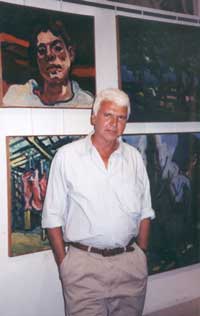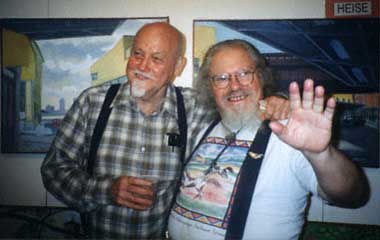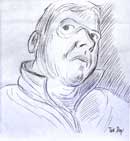Richard Ahntholz
Richard Ahntholz. has painted a picture of a church in France.
Its obvious that the church has been painted very quickly. This enhances its
visual spontaneity. Sort of like quickly signing one's name. There is plenty
of nuance and luminosity in this thinly painted picture. One of the few higher
key ones in the show. The landscape or should I say beachscape seems to arise
from the same aesthetic. A touch of Matise or late Monet is evident.
Ronald De Nota
De Nota's View from Little West 12th Street of a sunset through
an arched steel structure is one of the most magnificent paintings in the show.
Here we have a gem of a picture. The use of color is masterful. The composition
is good. The application of the paint is quite thick but not everywhere. It is
thick only in necessary places. It does not detract from the intensity of spirit
or the intensity of expression which is one of joyous celebration. This is the
trademark of DeNota's paintings. Here we see a fresh almost child-like delicacy
paired with great experiential spontaneity.
Jesse Benton Evans
In an unusual landscape we see a rainbow transforming. A flowingness
with earth (sea like) connected to a sky mixing with it. The picture is light
and airy. It fly's us away from New York to a place of reverent mystically, a
linking of heaven and earth.
Myron Heise
Mr. Heise has given to the world a wonderous picture which
masters scale composition and drawing along with a lonely sense of time. Myron,
is one of the few here who uses impasto only in specific places for specific
emphasis rather than for an overall effect. He does have an overallness though,
or should I say unity, in that he applies the paint broadly in large single colored
areas with a minimum modulation of color temperature. His painting of the elevated
structure with the van parked in front is successful in this regard . Much of
his work also has a haunting quality. His homeless men on a bench captures this
essence, But the painting of the news stand where Amadeo Diallo once worked also
deserves mention.
Ken McIndoe
Ken has three knockout pictures Sidewalk cover, Civil War,
and 99 cent Store on 14th St. Thickly textured, compositionally excellent, intelligently
distorted. Slightly reminiscent of Soutine, these works are museum quality.
Andy Pizzo
An orange church painted by Mr. Pizzo has an overall unity
of surface, spontaneous brush work and intelligently used color. The texture
here is not overstated but "just right " , that is, just right for this picture
which is one of magical flowing color power. This picture is another veritable
gem of this exhibition. Andy's mastery of experiential spontaneity in this work
is phenomenal. Pictures like this are truly heroic in contemporary American art.
What is wrong with museums today that they don't snap up works like this. Perhaps
their failure is the real form of censorship!
Richard Rask
Here we have Hans Hoffman like use of yellow with a possible
German expressionist connection . The paint surface is less thick then most in
the show but the effect has s scraped look about it, as if the work were stroked
by a palette knife. Mr. Rask has an excellent compositional sense, a little more
space to breath, and a limited and almost understated attention to subject matter.
The picture most striking is untitled but has a Gazebo in it.


